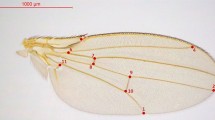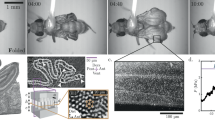Abstract
A study of 16 natural populations of Drosophila melanogaster from Eastern Europe, the Caucasus and Central Asia has revealed a cline in wing length associated with geographical position of the populations. Wing length was shown to be positively correlated with temperature. The coefficient of variation in wing length was significantly different in town and orchard populations. The existence of a cline in wing length in the northern part of the species range and in the region where migration must be substantial suggests strong selection pressure acting in natural populations of D. melanogaster.
Similar content being viewed by others
Article PDF
References
Allemand, R, and David, J R. 1976. The circadian rhythm of oviposition in Drosophila melanogaster: A genetic latitudinal cline in wild populations. Experientia, 32, 1403–1404.
Anderson, W W. 1966. Genetic divergence in M. Vetukhiv's experimental populations of Drosophila pseudoobscura. 3. Divergence in body size. Genet Res, 7, 255–266.
Anderson, W W. 1973. Genetic divergence among experimental populations of Drosophila pseudoobscura kept at different temperatures. Evolution, 27, 278–294.
Bubli, O A, and Imasheva, A G. 1994. Genetic differentiation of three quantitative traits in Drosophila melanogaster natural populations of Eastern Europe and Central Asia. Russian J Genet, 30, 57–63.
Cohet, Y, and David, J R. 1980. Geographic divergence and sexual behaviour: Comparison of mating systems in French and Afrotropical populations of Drosophila melanogaster. Genetica, 54, 161–165.
Cohet, Y, Vouidibio, J, and David, J R. 1980. Thermal tolerance and geographic distribution: A comparison of cosmopolitan and tropical endemic Drosophila species. J Therm Biol, 5, 69–74.
Coyne, J A, and Beecham, E. 1987. Heritability of two morphological characters within and among natural populations of Drosophila melanogaster. Genetics, 117, 727–737.
Coyne, J A, and Milstead, B. 1987. Long-distance migration of Drosophila. 3. Dispersal of D. melanogaster alleles from a Maryland orchard. Am Nat, 130, 70–82.
Coyne, J A, Boussy, J A, Prout, T, Bryant, S N, Jones, J S, and Moore, J A. 1982. Long-distance migration of Drosophila. Am Nat, 119, 589–595.
Coyne, J A, Bryant, S N, and Turelli, M. 1987. Long-distance migration of Drosophila. 2. Presence in desolate sites and dispersal near a desert oasis. Am Nat, 129, 847–861.
David, J R. 1979. Utilization of morphological traits for the analysis of genetic variability in wild populations. Aquilo SerZool, 20, 41–61.
David, J R, and Bocquet, C. 1975a. Evolution in a cosmopolitan species: genetic latitudinal clines in Drosophila melanogaster wild populations. Experientia, 31, 164–166.
David, J R, and Bocquet, C. 1975b. Similarities and differences in latitudinal adaptation of two Drosophila sibling species. Nature, 257, 588–590.
David, J R, and Kitagawa, O. 1982. Possible similarities in ethanol tolerance and latitudinal variations between Drosophila virilis and D. melanogaster. Jpn J Genet, 57, 89–95.
David, J R, and Capy, P. 1988. Genetic variation of Drosophila melanogaster natural populations. Trends Genet, 4, 106–111.
David, J, Bocquet, C, and De Scheemaeker-Louis, M. 1977. Genetic latitudinal adaptation of Drosophila melanogaster. new discriminative biometrical traits between European and equatorial African populations. Genet Res, 30, 247–255.
David, J R, Allemand, R, Van Herrewege, J, and Cohet, Y. 1983. Ecophysiology: abiotic factors. In: Ashburner, M., Carson, H. L. and Thompson, J. N. (eds) The Genetics and Biology of Drosophila, vol. 3, pp. 105–170. Academic Press, London.
Endler, J A. 1977. Geographic Variation, Speciation and Clines. Princeton University Press, Princeton, NJ.
Hyytia, P, Capy, P, David, J R, and Singh, R S. 1985. Enzymatic and quantitative variation in European and African populations of Drosophila simulans. Heredity, 54, 209–217.
Kingsolver, J G, and Koehl, M A R. 1985. Aerodynamics, thermoregulation, and the evolution of insect wings: differential scaling and evolutionary change. Evolution, 39, 488–504.
Latter, B D H, and Robertson, A. 1962. The effects of inbreeding and artificial selection on reproductive fitness. Genet Res, 3, 110–138.
Lemeunier, F, David, J R, Tsacas, L, and Ashburner, M. 1986. The melanogaster species group. In: Ashburner, M., Carson, H. L. and Thompson, J. N. (eds) The Genetics and Biology of Drosophila 3, pp. 147–256. Academic Press, London.
Louis, J, David, J R, Rouault, J, and Capy, P. 1982. Altitudinal variations of Afro-tropical D. melongaster populations. Dros Inf Serv, 58, 100–101.
Misra, R K, and Reeve, E C R. 1964. Clines in body dimensions in populations of Drosophila subobscura Genet Res, 5, 240–256.
Pfriem, P. 1983. Latitudinal variation in wing size in Drosophila subobscura and its dependence on polygenes of chromosome O. Genetica, 61, 221–232.
Powell, J R. 1974. Temperature related genetic divergence in Drosophila body size. J Hered, 65, 257–258.
Prevosti, A. 1955. Geographical variability in quantitative traits in populations of Drosophila subobscura Cold Spring Harbor Symp Quant Biol, 20, 294–299.
Reeve, E C R, and Robertson, F W. 1953. Studies in quantitative inheritance. II. Analysis of a strain of Drosophila melanogaster selected for long wings. J Genet, 51, 276–316.
Robertson, F W, and Reeve, E C R. 1952. Studies in quantitative inheritance. I. The effects of selection on wing and thorax length in Drosophila J Genet, 50, 414–448.
Singh, R S. 1989. Population genetics and evolution of species related to Drosophila melanogaster Ann Rev Genet, 23, 425–453.
Stalker, H D. 1980. Chromosome studies in wild populations of D. melanogaster. II. Relationship of inversion frequencies to latitude, season, wing-loading and flight activity. Genetics, 95, 211–223.
Stalker, H D, and Carson, H L. 1947. Morphological variation in natural populations of Drosophila robusta Sturtevant. Evolution, 1, 237–248.
Stalker, H D, and Carson, H L. 1948. An altitudinal transect of D. robusta Sturtevant. Evolution, 2, 295–305.
Tantawy, A O, and Mallah, G S. 1961. Studies in natural populations of Drosophila. I. Heat resistance and geographical variation in Drosophila melanogaster and D. simulans. Evolution, 15, 1–14.
Author information
Authors and Affiliations
Rights and permissions
About this article
Cite this article
Imasheva, A., Bubli, O. & Lazebny, O. Variation in wing length in Eurasian natural populations of Drosophila melanogaster. Heredity 72, 508–514 (1994). https://doi.org/10.1038/hdy.1994.68
Received:
Issue date:
DOI: https://doi.org/10.1038/hdy.1994.68
Keywords
This article is cited by
-
Seasonal variation in wing size and shape of Drosophila melanogaster reveals rapid adaptation to environmental changes
Scientific Reports (2022)
-
Climate stress resistance in male Queensland fruit fly varies among populations of diverse geographic origins and changes during domestication
BMC Genetics (2020)
-
Largely flat latitudinal life history clines in the dung fly Sepsis fulgens across Europe (Diptera: Sepsidae)
Oecologia (2018)
-
Drosophila as models to understand the adaptive process during invasion
Biological Invasions (2016)
-
Effects of body-size variation on flight-related traits in latitudinal populations of Drosophila melanogaster
Journal of Genetics (2014)



